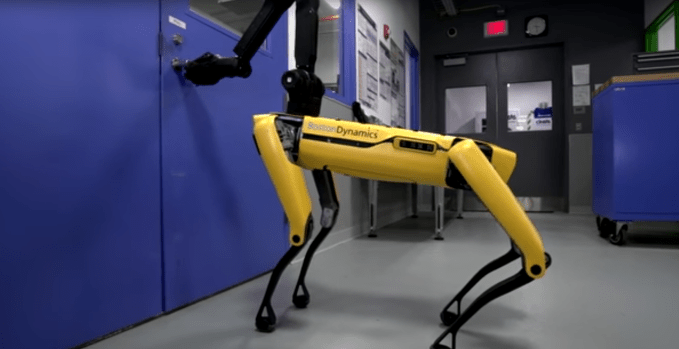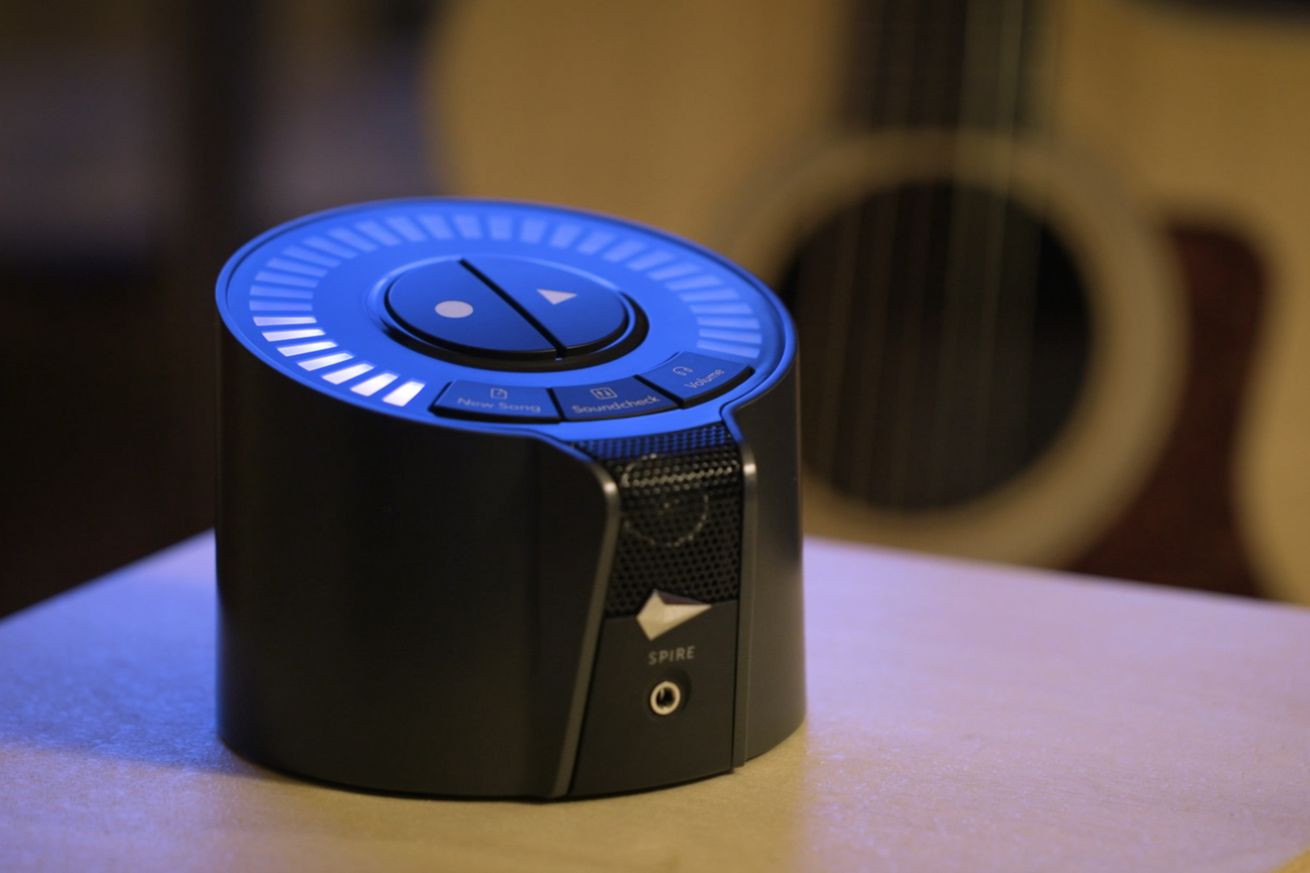
Jean-Philippe Encausse
Shared posts
Tooth-Mounted Diet Tracker Could Feed Our Unhealthy Relationship With Food
Is Fitbit not accurate enough for you? Apple Watch simply not invasive enough?
Maybe a wearable stuck to your tooth would be more your style.
Researchers at Tufts University have created just that. They’ve engineered a tooth-mounted sensor that tracks your every bite (and what it contains). Such a device could be useful, but it could also exacerbate our already-problematic relationship with food.
The device is two square millimeters in size and sticks to the surface of a tooth. The sensor is ingeniously simple — when its central layer changes encounters different chemicals (salt, ethanol), its electrical properties shift, transmitting a different spectrum of radio waves. Currently, the patch is set up to wirelessly transmit information about glucose, salt, and alcohol to a mobile device; its creators think it could be adapted to monitor even more metrics, including “a wide range of nutrients, chemicals and physiological states,” according to a press release.

With such a simple and inexpensive design, the sensor could be made widely available. That could be a huge boon to researchers who need a cheap way to track nutrients in a study, or to people who want to get their diet in check and for whom expensive fitness trackers are out of reach, or just don’t cut it. After all, let’s face it, we’re terrible at remembering what we ate, and how much of it.
But a tracker like this one could also have some negative side effects.
Mobile calorie and exercise-tracking apps already allow people to obsess over their every meal down to the macronutrient, and anecdotal evidence suggests doing so can exacerbate obsessive compulsive disorder (OCD) and eating disorders. Clinical psychologist Lara Pence, of the Renfrew Center Eating Disorder Treatment Facility, told New Republic: “It doesn’t really take research for us as an organization or for me as a clinician to see their damaging qualities.” She emphasized that the sense of guilt that trackers promote when a user surpasses their calorie allotment “speaks to the very core pathology of the disease: If I do this, then I have to do that.”
Indeed, one 2017 study found that fitness tracking devices in general were associated with eating disorder symptoms among college students (though, strangely, the same didn’t hold true for calorie counting apps). Unfortunately, there’s a considerable lack of clinical research on their broader impact.
How would a sensor that takes away the most labor-intensive part of fitness tracking — data entry — fit into that trend? To paint with a broad brush, modern culture already has an unhealthy obsession with appearance and body type. A tooth-mounted sensor probably wouldn’t give people eating disorders; these medical conditions are much more complex than that. But it could potentially worsen the symptoms of people who already have these disorders, and make it much easier for others to forget that eating sometimes isn’t just about calories and nutrients — it’s also something that can bring cultural understanding and, you know, joy.
The post Tooth-Mounted Diet Tracker Could Feed Our Unhealthy Relationship With Food appeared first on Futurism.
Google is adopting blockchain-like technology

Google is planning to adopt a blockchain-like ledger system, people familiar with the situation told Bloomberg. Google will use the tech, the report states, as a means of differentiating its cloud business from rivals. The company would also supposedly license the ledger system so that other companies could run it on their own servers.
Google was the second most active corporate investor in blockchain tech from the 2012 to 2017 period, according to CBInsights, just trailing after the Japan-based SBI Holdings. The company has also been investing and acquiring startups with digital ledger experience, the anonymous source told Bloomberg.
Other major tech companies like IBM and Microsoft also have active investments in blockchain-style...
Google Builds A Synthesizer With Neural Nets And Raspberry Pis.
AI is the new hotness! It’s 1965 or 1985 all over again! We’re in the AI Rennisance Mk. 2, and Google, in an attempt to showcase how AI can allow creators to be more… creative has released a synthesizer built around neural networks.
The NSynth Super is an experimental physical interface from Magenta, a research group within the Big G that explores how machine learning tools can create art and music in new ways. The NSynth Super does this by mashing together a Kaoss Pad, samples that sound like General MIDI patches, and a neural network.
Here’s how the NSynth works: The NSynth hardware accepts MIDI signals from a keyboard, DAW, or whatever. These MIDI commands are fed into an openFrameworks app that uses pre-compiled (with Machine Learning !) samples from various instruments. This openFrameworks app combines and mixes these samples in relation to whatever the user inputs via the NSynth controller. If you’ve ever wanted to hear what the combination of a snare drum and a bassoon sounds like, this does it. Basically, you’re looking at a Kaoss pad controlling rompler that takes four samples and combines them, with the power of Neural Networks. The project comes with a set of pre-compiled and neural networked samples, but you can use this interface to mix your own samples, provided you have a beefy computer with an expensive GPU.
!) samples from various instruments. This openFrameworks app combines and mixes these samples in relation to whatever the user inputs via the NSynth controller. If you’ve ever wanted to hear what the combination of a snare drum and a bassoon sounds like, this does it. Basically, you’re looking at a Kaoss pad controlling rompler that takes four samples and combines them, with the power of Neural Networks. The project comes with a set of pre-compiled and neural networked samples, but you can use this interface to mix your own samples, provided you have a beefy computer with an expensive GPU.
Not to undermine the work that went into this project, but thousands of synth heads will be disappointed by this project. The creation of new audio samples requires training with a GPU; the hardest and most computationally expensive part of neural networks is the training, not the performance. Without a nice graphics card, you’re limited to whatever samples Google has provided here.
Since this is Open Source, all the files are available, and it’s a project that uses a Raspberry Pi with a laser-cut enclosure, there is a huge demand for this machine learning Kaoss pad. The good news is that there’s a group buy on Hackaday.io, and there’s already a seller on Tindie should you want a bare PCB. You can, of course, roll your own, and the Digikey cart for all the SMD parts comes to about $40 USD. This doesn’t include the OLED ($2 from China), the Raspberry Pi, or the laser cut enclosure, but it’s a start. Of course, for those of you who haven’t passed the 0805 SMD solder test, it looks like a few people will be selling assembled versions (less Pi) for $50-$60.
Is it cool? Yes, but a basement-bound producer that wants to add this to a track will quickly learn that training machine learning algorithms cost far more than playing with machine algorithms. The hardware is neat, but brace yourself for disappointment. Just like AI suffered in the late 60s and the late 80s. We’re in the AI Renaissance Mk. 2, after all.
Google’s upcoming OLED display for VR headsets may pack a 3182p resolution
Google is scheduled to hold a session during Display Week in May to introduce its 18-megapixel OLED display built for virtual reality headsets. It will have a refresh rate of 120Hz and a pixel density of 1,443 pixels per inch.
The post Google’s upcoming OLED display for VR headsets may pack a 3182p resolution appeared first on Digital Trends.
Gorgeous VR Train Sim Rolling Line Gets Release Date, New Trailer
We like to refer to lots of third-person VR games as ‘train set VR’ here at UploadVR, but Rolling Line takes that definition very seriously.
Rolling Line is the latest game from Gaugepunk Games, the team that brought you Frontier VR and Echo Grotto. It’s a model train simulator that lets you build and organize your own miniature train network, laying down tracks for freight trains to follow in scenery inspired by the developer’s home of New Zealand. The game includes a pre-built table as well as space for you to create your own worlds.
Take a look at the trailer above, which keeps Frontier and Echo Grotto’s gorgeous art style intact.
As you can see, being in VR allows Rolling Line to take advantage of a few features you couldn’t get with a real model train set (and saves you a bit of space in the real world). For starters, there’s a weather system so that you can view journeys in the rain or the sun. More importantly, though, you can shrink down to explore the world in first-person as if it had come to life and even ride the trains themselves.
Rolling Line will hit Steam on April 6th with support for both the Oculus Rift and HTC Vive, but will also support standard PC play, too.
Tagged with: Rolling Line
Dockless bike-share service leaves France after ‘mass destruction’ of its fleet

Hong Kong-based bike-sharing service Gobee is shutting down in France after suffering what the company is calling “mass destruction” of its fleet. Gobee, which had 2,000 bikes in Paris and claimed around 150,000 users across the country, says 3,400 of the company’s bikes have been damaged and more than 1,000 have been stolen, according to The Guardian.
Gobee’s troubles are the latest example of the uphill battle for so-called “dockless” bike-sharing. These systems ditch the need to fetch or return a bike at a full dock or rack and instead allow riders to leave the bikes wherever they like. Rather than paying at a kiosk, people are able to unlock the bikes and pay for the ride with a mobile app, and they don’t have to go out of their way...
PIC: Every Stan Lee Marvel Movie Cameo Ever
This picture by reddit user l_l_l-illiam includes every single cameo that featured Stan Lee, starting with The Trial of the Incredible Hulk in 1989, right up to Thor: Ragnarok (2017.) If you want to see his cameo in Black Panther, you’ll have to go see the film because pictures of it are still not available online.
If you want a bigger version of the picture below, just click on it!
The post PIC: Every Stan Lee Marvel Movie Cameo Ever appeared first on Geeks are Sexy Technology News.
ARKit could bring your nightmares into your living room

I’ve never seen The Ring because I’m a huge baby, but I’ve now watched a terrifying augmented reality demo of its main villain Samara coming out of the TV screen, just like in the movie. A developer named Abhishek Singh, who has created lots of AR experiences, tweeted his idea of The Ring in AR.
I reenacted a famous scene from 'The Ring' to bring #horror movies to life in AR#madewithunity #ARKit pic.twitter.com/fRU2ul56ki
— Abhishek Singh (@shekitup) February 21, 2018
Samara not only comes out of the screen, but she follows the user around the room and shows up in hallways. It’s terrifying, especially for a baby like me. Another developer, Mike Woods, created a Ring experience with ARKit earlier this year, but it isn’t as scary as...
DIY Peristaltic Pump Keeps the Booze Flowing
A few months ago we showed you a bar bot built by [GreatScott] that uses peristaltic pumps to food-safely move the various spirits and mixers around behind the curtain. The bar bot uses three of them, and at $30 each for pumps with decent flow rate, they added a lot to the parts bill. These pumps are pretty much the ideal choice for a bar bot, so what do you do? [GreatScott] decided to see if it was worth it to make them instead.
Peristaltic pumps are simple devices that pump liquids without touching them. A motor turns a set of rollers that push a flexible tube against a wall. As the motor turns, the rollers move liquid through the tube by squeezing it flat from the outside in turns. Typically, the more you pay for an off-the-shelf peristaltic, the higher the flow rate.
[GreatScott] figured it was cheaper to buy the motor and the control circuitry. He chose a NEMA-17 for their reputation and ubiquity and a DRV8825 controller to go with it. The pump is driven by an Arduino Nano and a pot controls the RPM. After trying to design the mechanical assembly from scratch, he found [Ralf]’s pump model on Thingiverse and modified it to fit a NEMA-17.
The verdict? DIY all the way, assuming you can print the parts. [GreatScott] was trying to beat the purchased pumps’ flow rate of 100mL/minute and ended up with 200mL/minute from his DIY pump. Squeeze past the break for the build video and demonstration.
Is there a bar bot build on your list? No? Is it because you’re more of a single-malt scotch guy? Build a peristaltic pachyderm to pour your potion.
Microsoft expands Cortana for the smart home with IFTTT integrations

Today, Microsoft announced that its digital assistant, Cortana, will now work with IFTTT and a number of new smart home devices, such as the Ecobee, Honeywell Lyric, and LIFX. To set them up, just open Cortana on Windows 10 or launch the Cortana app and add the new products under the Connected Home menu.
The IFTTT compatibility helps open Cortana up to a number of new third-party services. Rather than wait for third-party companies to offer new Cortana features, just as they do for Amazon Alexa skills, users can find “recipes” that already exist on IFTTT’s platform and connect them to their Cortana-enabled device.
The update today comes several months after the release of Microsoft’s first Cortana smart speaker, the Harmon Kardon Invoke....
L’enfer de la maison intelligente
Sur Gizmodo, la journaliste Kashmir Hill (@kashhill) raconte comment elle a décidé de transformer son petit appartement de San Francisco en maison connectée. Elle s’est équipée d’un assistant vocal Echo d’Amazon, de lumières connectées, d’une cafetière connectée, d’un roomba, a branché sa brosse à dents, sa télé, son lit, un cadre photo… Un peu tout ce qui est disponible sur le marché. L’enjeu était de regarder ce que sa maison pourrait lui apprendre. Avec l’aide d’un collègue artiste et ingénieur, Surya Mattu (@suryamattu), elle a enregistré toutes les données que ces appareils échangeaient avec l’extérieur.
Le premier constat que la journaliste a tiré de cette expérimentation est que ces objets ont été une « source constante d’agacement ». Vivre dans une maison intelligente est exaspérant. Il lui a fallu télécharger 14 applications différentes sur son téléphone pour faire fonctionner ces appareils. Les configurer reste chronophage, notamment parce qu’ils ne sont pas toujours conçus pour discuter les uns avec les autres, au contraire ! Par exemple, elle a passé du temps à configurer Alexa pour qu’il allume une guirlande de Noël à la demande. Mais du jour au lendemain, cette configuration a cessé de fonctionner. Autre problème : il fallait demander tous les soirs à Alexa d’éteindre les lumières les unes après les autres (« Alexa, éteint la guirlande », « Alexa était la lumière du salon »…) : ce qui est bien plus ennuyant que de les éteindre à la main !
Faire travailler ensemble différents appareils de différentes marques signifie en fait que ça prend bien plus de temps à faire que de le faire à la main !
Autre problème bien sûr : la difficulté de connecter les appareils entre eux ! Impossible par exemple de connecter sa machine à café avec Alexa d’Amazon, tant et si bien qu’il lui a fallu en changer. Mais le modèle qui fonctionnait avec Alexa ne fonctionnait pas avec le capteur de son matelas ni avec ses prises électriques connectées : donc impossible de déclencher automatiquement son café au saut du lit ! Sans compter que le capteur vocal d’Amazon avait du mal à reconnaître le nom de la machine à café… tant et si bien qu’il était le plus souvent plus simple de se lever pour se faire le café !
Si Kashmir Hill a beaucoup apprécié son aspirateur autonome, notamment parce qu’il faisait très bien son travail, celui-ci n’a cessé de la harceler sur son téléphone, lui envoyant des notifications dès qu’il était coincé ou plein ! « Je pensais que ma maison prendrait soin de moi », alors qu’en fait, elle était plus sollicitée encore par les choses connectées qui lui demandaient de prendre soin d’elles !
En ce qui concerne la vie privée, l’analyse des données s’est révélée préoccupante. Les interrupteurs électriques connectés permettant de faire fonctionner les lumières à distance n’ont pas cessé d’envoyer des informations à l’extérieur, et pas seulement quand on les faisait fonctionner. La caméra de sécurité connectée a pris une vidéo d’elle se promenant nue dans son salon pour l’envoyer dans le cloud ! Celle-ci envoyait d’ailleurs constamment de grosses quantités de données. Pareil pour la télé !
Dans ce panoptique familial infernal, la conclusion qu’en tire Kashmir Hill, c’est que notre surveillance à l’heure de l’internet des objets ne va pas cesser de s’étendre. En analysant les données envoyées par ses objets, sont collègue savait quand ils se levaient, se couchaient, quand ils regardaient la télé ou quand ils se brossaient les dents. Pour lui, l’aspect le plus inquiétant a été de constater en fait que « tous les appareils téléphonaient chez eux tous les jours, même s’ils n’avaient pas été utilisés » (et pour Amazon Echo, la connexion aux serveurs d’Amazon se fait même toutes les deux minutes !). L’ingénieur était capable de voir quand la maison était vide, car la quantité de données était ralentie mais jamais inexistante. Son constat est assez clair : la maison connectée s’apprête à créer de nouveaux flux d’information, un open-bar sur vos données !
« Tous les appareils connectés téléphonent constamment à leurs fabricants. Vous ne serez pas au courant que ces conversations se déroulent à moins que vous soyez techniquement avertis ou que vous surveillez votre routeur comme nous l’avons fait. Et même si vous l’êtes, parce que les conversations sont généralement chiffrées, vous ne serez pas en mesure de voir ce que vos affaires disent de vous. Lorsque vous achetez un appareil intelligent, il ne vous appartient pas seulement : vous en partagez la garde avec la compagnie qui l’a fabriqué ! »
De quoi relativiser pleinement le fameux adage : « si c’est gratuit, c’est vous le produit ! » Car si c’est payant, c’est vous aussi !

Boston Dynamics’ newest robot learns to open doors
 We knew this day would come sooner or later. Like the cloned velociraptors before it, Boston Dynamics’ newly redesigned Spot Mini has figured out how to open doors — with either its arm or face, depending on how you look at it. Read More
We knew this day would come sooner or later. Like the cloned velociraptors before it, Boston Dynamics’ newly redesigned Spot Mini has figured out how to open doors — with either its arm or face, depending on how you look at it. Read MoreAmazon SWA : Un service de livraison interne comme relais de croissance
L’information vient du Wall Street Journal qui décrit l’Amazon SWA comme un nouveau service qui devrait voir le jour assez rapidement, dans une phase d’essai, pour effectuer la livraison des colis de la plateforme vers les clients finaux.
Aujourd’hui, Amazon utilise des services tiers pour effectuer ses livraisons : En France, on a La Poste, Colis Privé, UPS, Relais colis, Mondial Relais, DPD, Chronopost et une ribambelle d’autres pour les plus connus. Chacun de ces prestataires étant commandé suivant de multiples critères de localisation, de poids des colis et de vitesse de traitement souhaitée. Cette dernière étape n’est donc absolument pas maîtrisée par Amazon. Elle devient surtout une source de dépenses importantes pour la marque. Plusieurs spécialistes de la logistique estiment que certains des envois calculés au forfait coûtent plus qu’ils ne rapportent. Révélant ainsi qu’un gros succès d’Amazon lui ferait perdre de l’argent…
Le réflexe le plus logique pour Amazon semblerait donc de maîtriser cette dépense en transformant un poste coûteux en une branche rémunératrice. Amazon a peut être atteint le point de bascule où l’existence de son propre réseau de distribution serait plus rentable que de passer par des tiers.
Selon le Wall Street Journal, la marque serait en train de construire l’infrastructure nécessaire à un test grandeur nature à Los Angeles. Dans la ville, les utilisateurs du site seraient livrés par Amazon via des chauffeurs maison et non plus des prestataires. Cela veut dire que tous les produits expédiés par la marque seraient gérés de l’entrepôt jusqu’à la porte du client par Amazon. Les marques utilisant le site comme plateforme de vente pourraient, elles-aussi, profiter de ce système de distribution.
Pour que cela soit possible – et rentable – il faut réunir deux éléments importants. D’abord une large base d’utilisateurs ayant opté pour un abonnement forfaitaire qui, contre une somme annuelle, ne fait plus payer les frais de port des commandes. Effet positif pour le distributeur de ce forfait, les gens ont tendance à commander compulsivement jusqu’à plusieurs fois par jour. Un effet encouragé par Amazon avec les systèmes mis en place comme les Dash Buttons. Si le nombre d’abonnés Prime devient trop important, le nombre de livraisons explose alors que le financement de celles-ci reste fixe puisque limité au montant des forfaits. On se doute que ce n’est pas avec des commandes de chips à livrer pour le lendemain sans frais de port qu’Amazon va rentabiliser ce type d’offre.
Mais si on fait le détail du coût des livraisons et qu’on le met en perspective d’un service complet dans une infrastructure interne, on peut tendre à une maîtrise de ce coût sur la durée. On sait combien va nous coûter le service mensuellement en terme de salaires, de flotte de véhicules et d’immobilier et on peut alors le rentabiliser.
Car le second élément que la mise en place de ce service rend possible, c’est la mise en concurrence des transporteurs actuels : FeDex, UPS et autres. En proposant le service Amazon SWA à l’ensemble des distributeurs de sa plateforme, Amazon gagnerait de l’argent plutôt que de le voir partir chez les transporteurs tiers qui livrent actuellement aux US. Mieux encore, Amazon pourrait tout à fait concurrencer ces marques en proposant ses services à tout le monde. En ouvrant des bureaux, en organisant des ramassages de colis pendant ses tournées ou en installant du mobilier urbain destiné à des collectes et dépôts. Avec ce système, l’entreprise bénéficierait à la fois d’une maîtrise de sa dépense de livraison mais pourrait surtout gagner de l’argent en distribuant les colis des autres.
Evidemment la rentabilité d’un tel système ne serait possible qu’en multipliant l’offre à d’autres villes aux US voir à d’autres territoires. Mais la marque a de l’argent et peut tout à fait employer les méthodes – peu reluisantes – de ses concurrents sur ce secteur. C’est à dire embaucher à tour de bras des prestataires de service payés au colis qui se serviront d’une flotte de camions d’Amazon SWA et d’un joli costume pour faire le travail. On imagine que la marque saura les pister au mètre près pour “optimiser” leurs parcours.
On imagine également que les contrats en place actuellement entre le site marchand et les transporteurs historiques lui permettrait de glisser ses paquets Amazon SWA dans le flux de ses colis traditionnels. En faisant payer le prix “classique” d’un transport UPS ou FeDex et en bénéficiant d’un tarif très préférentiel en tant que gros client. La différence pourrait donc atterrir dans ses poches et le service livrer partout dans le monde. Une manière habile de se lancer en attendant le déploiement de plus de points de distributions dans d’autres villes et pays.
Cette méthode de lancement d’un service secondaire par rapport au fonctionnement de leur site de base n’est pas nouvelle. C’est exactement ce que la marque a fait pour son système de Cloud quand elle en a eu un besoin vital. Amazon AWS est né quand le site a connu une croissance fulgurante puis est devenu un business à part entière quand la marque a commencé à proposer ses serveurs et prestations à des entreprises tierces. Aujourd’hui, Amazon est un des géants du Cloud dans le monde, ce qui permet non seulement d’assumer ses besoins d’infrastructure web mais également de dégager de confortables marges.
Si Amazon AWS a fonctionné, Amazon SWA pourrait suivre le mouvement.
source: Wall Street Journal.
Amazon SWA : Un service de livraison interne comme relais de croissance © MiniMachines.net. 2017
Amazon launches a Polly WordPress plugin that turns blog posts into audio, including podcasts
 Amazon today is launching a new Amazon Polly WordPress plugin that gives your blog a voice by creating audio versions of your posts. The resulting audio can be played from within the blog post itself, or accessed in podcast form using a feature called Amazon Pollycast, the company says. The plugin itself was jointly designed by Amazon’s AWS team and managed WordPress platform… Read More
Amazon today is launching a new Amazon Polly WordPress plugin that gives your blog a voice by creating audio versions of your posts. The resulting audio can be played from within the blog post itself, or accessed in podcast form using a feature called Amazon Pollycast, the company says. The plugin itself was jointly designed by Amazon’s AWS team and managed WordPress platform… Read MoreDécouvrez le premier sport en réalité augmentée
Préparez-vous, le premier tournoi de sport en réalité augmentée est lancé et promet de devenir viral ! Connaissez-vous Hado ? Au Japon ce sport est un vrai succès ! Sa particularité ? Il s’agit d’un e-sport qui se pratique avec un casque d’AR et un bracelet connecté. En équipe, vous affrontez vos adversaires aidé de vos armes : des boules d’énergie pour attaquer et un bouclier pour vous défendre.
Entrez dans la réalité augmentée
En combinant stratégie, réflexion, réflexes, agilité et travail d’équipe, vous débloquez des attaques spéciales et progressez pour éliminer tous vos opposants. Ce sport se pratique dans des arènes virtuelles localisées dans des parcs à thème ou des centres commerciaux.
Face au succès d’Hado, le premier championnat du monde de sport AR vient d’être lancé et verra s’affronter 12 équipes de trois pays différents. Les États-Unis se sont même emparés du concept et prévoient de l’adapter.
Que le match commence !

L’article Découvrez le premier sport en réalité augmentée est apparu en premier sur GOLEM13.FR.
“C’est trop cher” : 8 actions qui nous ont permis de dépasser cette objection
Dans cet article nous analysons comment nous avons fait comprendre la valeur de notre produit et donc son prix. Dans notre situation il est assez difficile de diminuer le prix. Nous payons 8,65€ de…

Commentaires
L'article “C’est trop cher” : 8 actions qui nous ont permis de dépasser cette objection a été posté dans la catégorie Entrepreneuriat de Human Coders News
How to sleep easier with Google Home’s white noise feature

I’m one of those people who falls asleep a little easier if there’s quiet, steady noise around me. Cracking a window open isn’t really an option in February here in New York, so typically I just turn on a small fan in my room to get that fix of white noise. But a couple weeks ago, I learned that Google Home speakers can play white noise audio on demand. And I was pleasantly surprised by how good it sounds — even on my tiny Google Home Mini, which has slightly improved bass compared the Amazon Echo Dot in my living room. I’m sure the effect is better on a regular Home or the Home Max. This also works through Google Assistant on your phone in a pinch, and the sounds can be played on any Assistant-enabled speaker.
You can trigger ambient...
Google Flights will now predict airline delays – before the airlines do
 Google is rolling out a few new features to its Google Flights search engine to help travelers tackle some of the more frustrating aspects of air travel – delays and the complexities of the cheaper, Basic Economy fares. With the regard to delays, Google Flights won’t just be pulling in information from the airlines directly, however – it will take advantage of its… Read More
Google is rolling out a few new features to its Google Flights search engine to help travelers tackle some of the more frustrating aspects of air travel – delays and the complexities of the cheaper, Basic Economy fares. With the regard to delays, Google Flights won’t just be pulling in information from the airlines directly, however – it will take advantage of its… Read MoreMicrosoft’s Slack competitor, Teams, gets its biggest update with new app integrations and app store
 Microsoft’s Slack competitor, Microsoft Teams, rolled out its biggest update since the software’s launch last year, the company says. The focus of the new set of features is allowing users to better work with apps – something Microsoft Teams accomplishes via integrations, new search and discovery features, commands, and more.
Some of the features are, in fact, quite… Read More
Microsoft’s Slack competitor, Microsoft Teams, rolled out its biggest update since the software’s launch last year, the company says. The focus of the new set of features is allowing users to better work with apps – something Microsoft Teams accomplishes via integrations, new search and discovery features, commands, and more.
Some of the features are, in fact, quite… Read MoreThe people making fake AI porn have been temporarily distracted by Nicolas Cage

Over the past few months, the internet has found a creepy new hobby: using artificial intelligence to paste the faces of celebrities onto porn videos. The technology has some disturbing implications, especially with regards to consent, harassment, and fake revenge porn. But on Reddit, where most of this content is being shared, users have found at least one wholesome (sort of) use for it: inserting Nicolas Cage into movies he never acted in.
Cage has long been an internet favorite, thanks in part to his willingness to appear in just about anything. Now, with the help of AI, his likeness can be seen in an even wider range of roles: replacing Sean Connery as James Bond in Dr. No; standing in as Indiana Jones in Raiders of the Lost Ark; and...
Display screen offers alternative to augmented reality headset

Despite AR and VR headsets being an attractive display option for many companies, some are more interested in an inclusive offerings rather than the single experience headset variant. Denmark-based Realfiction has created DeepFrame, a 64-inch screen that operates the same way as such a headset. DeepFrame is a revolutionary mixed-reality (MR) display that blends the physical and digital elements in real-time. It allows spectators to collectively experience lifelike animations in any size and at any distance without the use of special glasses.
DeepFrame is capable of projecting large-scale holograms thanks to a curved video screen that deflects interactive 3D images in 4K resolution onto a glass optic. This magnifies the image giving the illusion of three dimensions rather than just two. The technology could be used in a number of applications such as museums, amusement parks and retail outlets.
We have seen how virtual reality has been adopted in a multitude of ways, such as a performance piece incorporating dance and VR to create a unique display, or being used to honour the dead. How could you use MR in your business?
Website: www.realfiction.com
Contact: www.realfiction.com/contact
The post Display screen offers alternative to augmented reality headset appeared first on Springwise.
Amazon Echo Spot launches in the UK, Germany, and Austria

After launching in the US a little over a month ago, Amazon’s Echo Spot is starting to ship internationally. Its first stops are the UK, Germany, and Austria, where the small new Alexa device goes on sale today.
The Echo Spot is Amazon’s second Echo device with a touchscreen. And while it can do all the same things as the much larger Echo Show, its clock-like shape and size mean it’s better used in much different ways, like as a bedside alarm. At least, so long as you’re comfortable with the Spot’s built-in webcam constantly staring at you.
Amazon sells the Echo Spot for $130 in the US, and while that price tag carries over, it ends up being more expensive elsewhere after converting currencies. It’ll sell for £119.99 in the UK (about...
Shopping at Amazon’s Go stores feels like a heist. And we love it
With an app, an Amazon account, and a bright orange bag, you can walk into the Amazon Go grocery store and walk out without waiting in a checkout line.
The post Shopping at Amazon’s Go stores feels like a heist. And we love it appeared first on Digital Trends.
Spire Studio is a recording studio that fits in your hand

Izotope is best known for creating audio software, but a couple weeks ago, I got to check out Spire Studio, the company’s first piece of hardware. Spire Studio is a palm-sized device that musicians can carry with them to record professional-grade multitrack audio anywhere they are.
While there are lots of gadgets on the market for portable recording, most interfaces I’ve seen need to be plugged in to your phone, cater to recording a specific type of instrument, or are wired and need lots of dongles. Spire Studio, on the other hand, has a lot of use in a very small footprint, and connects to your phone wirelessly. On the front is a built-in mic and headphone jack, while the back has two XLR/TS combo jacks, another headphone jack, and a...
Car head-up display maker Navdy says units may stop functioning
Car head-up display maker Navdy is shutting down. The company sent emails to customers noting that it is liquidating its assets and that units already bought by customers may soon stop working.
The post Car head-up display maker Navdy says units may stop functioning appeared first on Digital Trends.
Facebook invented a new time unit called the ‘flick’ and it’s truly amazing
 I was all set to dislike the “flick,” a time unit just recently invented by Facebook (technically the Oculus team), because I thought it was going to be something worthless like “the average time someone looks at a post.” In fact it’s a very clever way of dividing time that theoretically could make video and audio production much more harmonious. Read More
I was all set to dislike the “flick,” a time unit just recently invented by Facebook (technically the Oculus team), because I thought it was going to be something worthless like “the average time someone looks at a post.” In fact it’s a very clever way of dividing time that theoretically could make video and audio production much more harmonious. Read MoreReal-Time Green Screen Compositing Demo
It looks so cool!..(Read...)
The Amazon Go checkout-free grocery store opens to the public January 22
After more than a year of employee-only testing, the Amazon Go grocery store in Seattle is finally open for business. The premise is simple -- just walk in, grab what you want, and then walk out. But will it really work?
The post The Amazon Go checkout-free grocery store opens to the public January 22 appeared first on Digital Trends.
Brass Tactics Is Getting A Free Version, Pre-Orders Go Live
Still not sure if Hidden Path Entertainment’s Rift-exclusive real-time strategy (RTS) game, Brass Tactics, is for you? You’ll soon be able to find out at no extra cost.
Hidden Path today announced that the game, which was delayed from last 2017 into 2018, will be getting a free version called Brass Tactics Arena. In this version, you’ll be able to play unlimited online and single-player matches on one of the game’s maps with a handful of the units available in the full version. You can play competitive and cooperative modes on this map to your heart’s content and then, if you like what you play, you can unlock more by picking up the full version.
The full edition of Brass Tactics will boast over 20 maps, more units and a six-hour campaign to play through as well as a suite of online options. Brass Tactics Arena will launch on February 15th for those that register over here, giving players a week to hone their skills before the entire game launches on February 22nd.
Brass Tactics was first revealed back at GDC 2017 and we were big fans of it. The game presents its brand of warfare as a tabletop diorama that you can explore to your heart’s content, capturing defense points and advancing on the enemy base. We’re hoping it will set the bar for RTS games in VR going forward.
Pre-orders for the full game open today at a discounted price of $24.99. When the game launches it’ll cost $39.99.
Tagged with: brass tactics

















